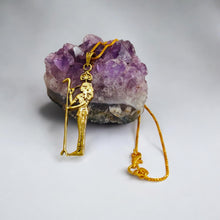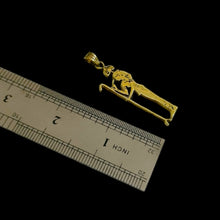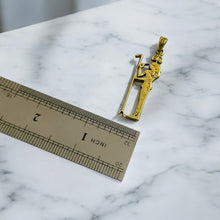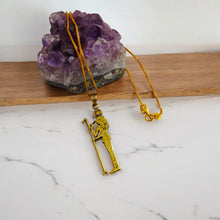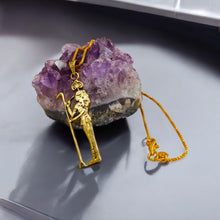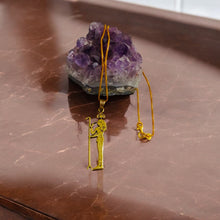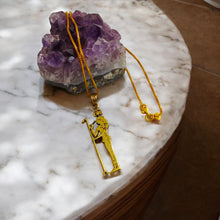
The Gold Goddess Seshet The Scribe Pendant Necklace pays homage to the ancient Egyptian deity Seshet, goddess of writing, wisdom, and architecture. Crafted in luxurious gold, this pendant captures the essence of Egyptian history and culture in a timeless piece of jewelry.
- History: Inspired by ancient Egyptian mythology, representing Seshet, the goddess of writing, wisdom, and measurement.
- Spiritually: Symbolizes creativity, knowledge, and divine inspiration.
- Talisman: Carries the energy of Seshet, believed to enhance intellect and intuition.
- Handmade: Crafted with care, ensuring attention to detail and quality.
- Healing: Thought to promote mental clarity and spiritual growth.
- Material Gold: Made of gold, a symbol of purity, wealth, and spiritual enlightenment.
- Symbolism: Depicts Seshet holding a papyrus scroll, signifying her role as a divine record-keeper and patroness of writing.
- How to Wear: Easily attaches to any chain up to 5mm thick, allowing for versatile styling.
- Ideal Gift: Perfect for those seeking inspiration, wisdom, or a connection to ancient spirituality.
History Side For Those Who Are Interested
Seshat, the ancient Egyptian goddess of wisdom, knowledge, and writing, holds a significant place in the pantheon of Egyptian deities. Her origins trace back to the Early Dynastic Period (circa 3100–2686 BCE), although she became more prominent during the Old Kingdom (circa 2686–2181 BCE) and continued to be revered throughout Egyptian history.
The name "Seshat" is believed to mean "female scribe" or "she who scrivens" in ancient Egyptian, emphasizing her association with writing and record-keeping. She was often depicted as a woman wearing a leopard skin garment or a dress made of stars, with a headdress resembling an inverted seven-pointed star or an ostrich feather.
Seshat played a vital role in Egyptian mythology as the consort of Thoth, the god of wisdom, writing, and magic. Together, they were the divine patrons of knowledge and learning. However, Seshat had her distinct domain as the goddess of writing, measurement, and architecture. She was closely associated with the scribal arts, particularly the recording of the pharaoh's deeds, the measurement of land for taxation purposes, and the construction of temples and other monumental structures.
One of Seshat's primary functions was to assist the pharaoh in the ritual of "stretching the cord," which symbolized the act of laying out the boundaries of sacred and secular spaces. This ritual was crucial for the construction of temples, tombs, and cities, ensuring that they were aligned with cosmic order and divine principles.
In addition to her role in architectural and administrative contexts, Seshat was also revered as a protector of the written word and a guardian of knowledge. She was believed to be present during important events such as the coronation of pharaohs and the recording of historical events, ensuring their accuracy and perpetuity.
As a goddess associated with wisdom and foresight, Seshat was often invoked by rulers and individuals seeking guidance in matters of governance, planning, and decision-making. Temples dedicated to her worship were built throughout Egypt, with prominent cult centers in Memphis, Heliopolis, and Thebes.
Despite her widespread veneration, Seshat's cult declined in significance during the later periods of Egyptian history, particularly after the decline of traditional Egyptian religion following the conquest of Egypt by foreign powers. However, her legacy endured through the preservation of ancient texts and the continued fascination with Egyptian mythology and symbolism in modern times. Today, Seshat remains an enduring symbol of wisdom, knowledge, and the written word in the rich tapestry of ancient Egyptian religion and culture.











